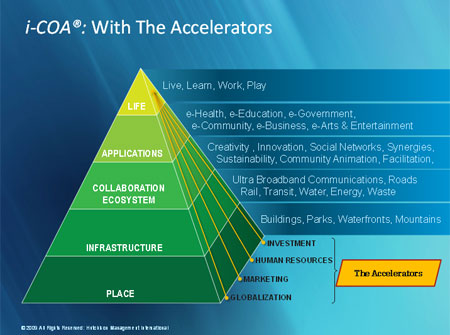The past six weeks have been a whirlwind, focused on u-, e-, m-, and i-communities and their economic and social revitalization around the world. Our Intelligent Community and urban revitalization activities at Waterfront Toronto (www.waterfrontoronto.ca) have kept me busier than usual as we worked to finalize the contract for the advanced ultra broadband infrastructure. But everyone also plans their pre-summer wrap up meetings in May and June and that introduced plenty of travel into my schedule.
First was the New York based Intelligent Community Forum (ICF)’s annual conference with its announcement of the Intelligent Community of the Year – Stockholm – and other awards, which you can see at www.intelligentcommunity.org. I was honored to participate again this year as a member of the international jury that reviewed the information for the Final Seven and then ranked their submissions to determine the winner.
Next up was a trip to Seoul, South Korea to participate in Cisco’s Connected Urban Development (CUD) meeting and to visit the Inchon Free Economic Zone (IFEZ), a very large and impressive initiative. During my visit we agreed to work on developing a collaborative relationship between Waterfront Toronto and IFEZ. The CUD is Cisco’s investment in the Clinton Global Initiative to study how ICT can help to reduce the carbon footprint of cities. It too is an impressive initiative involving projects in seven cities: San Francisco, Seoul, Amsterdam, Madrid, Lisbon, Hamburg and Birmingham.
At the end of June, I was in Ottawa assisting Professor Tony Bailetti of Carleton University in his “Lead to Win” initiative to help small start-up companies refine their business plans as part of a larger job creation initiative in Ottawa. Professor Bailetti has developed some well respected concepts for Open Innovation and Waterfront Toronto is looking forward to adopting many of the concepts and to introducing Lead to Win in Toronto.
The theme of this year’s ICF conference was “Building the Broadband Economy” and I was pleased to speak and unveil i-COA®, the Five Layer Intelligent Community Open Architecture® model. The purpose of this architecture is to provide a framework for community leaders who wish to create the world’s leading Intelligent Communities. Anyone can use the model and we hope it will be treated like an open source product with others adding to it to share with the world. It is registered by Hutchison Management International to maintain editorial integrity as it evolves but is available at no cost for anyone to use. I encourage everyone’s feedback – check the Contact Us page to discuss it with me.
Jane Jacobs would have loved i-COA, as she argued in her ground breaking 1961 book The Death and Life of the Great American Cities that cities are living organisms and architects from Ebenezer Howard with his 19th century Garden Cities to Le Corbusier have all made the mistake of only addressing part of the equation for a great city. They have tended to focus on the architecture and other physical attributes like street layouts, but Jacobs argued that they missed the elements that create the heart and soul of the really great and livable neighborhoods and cities. This is one of the challenges faced by Dubai – lots of architecture but missing the soul. We developed i-COA to help explain the difference between an iconic architectural initiative and a true community building initiative after my visit to Dubai last November.
Figure 1 below shows the five layers of i-COA®. Layer 3, the Collaboration Ecosystem, is what I call the Jacob’s Layer … updated with some of Richard Florida’s Creative Class. Jacobs and Florida both argue for the importance of the soul of the great community.

Figure 2 adds the Accelerators. They have a big impact on the rate and nature of economic and social development of the community. Coincidentally, the communities that have won the Intelligent Community of the Year over the past 15 years have all implemented most of the elements of i-COA. More will be said of the characteristics and details of the various layers in i-COA in the coming weeks.

* ”i-COA” and “The Intelligent Community Open Architecture” are registered trademarks of Hutchison Management International.
 If you have access to fast broadband, your friends all work online and it is easy to find venture capital, then you are in a digital hub. And you’re not in Canada. Our country trails the world when it comes to building these centres of digital innovation. In this episode of “Our Digital Future – Digital Hubs”, leading voices from Canada’s digital community discuss the characteristics of a good digital hub and the investment needed to create intelligent communities for tomorrow’s digital economy. The episode features: Mark Kuznicki, a leader in the field of citizen and community engagement; Sarah Prevette, founder of Sprouter.com, an online community for entrepreneurs; Jesse Brown, journalist and an influential voice in the world of social media; and, Bill Hutchison, the Executive Director of Intelligent Communities for Waterfront Toronto and a renowned business and social entrepreneur.
If you have access to fast broadband, your friends all work online and it is easy to find venture capital, then you are in a digital hub. And you’re not in Canada. Our country trails the world when it comes to building these centres of digital innovation. In this episode of “Our Digital Future – Digital Hubs”, leading voices from Canada’s digital community discuss the characteristics of a good digital hub and the investment needed to create intelligent communities for tomorrow’s digital economy. The episode features: Mark Kuznicki, a leader in the field of citizen and community engagement; Sarah Prevette, founder of Sprouter.com, an online community for entrepreneurs; Jesse Brown, journalist and an influential voice in the world of social media; and, Bill Hutchison, the Executive Director of Intelligent Communities for Waterfront Toronto and a renowned business and social entrepreneur.
